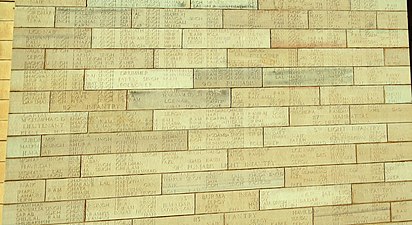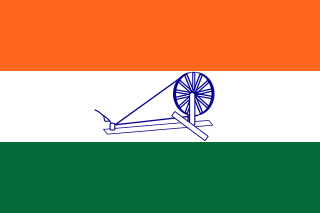
The Indian National Army was a collaborationist armed unit of Indian collaborators that fought under the command of the Japanese Empire. It was founded by Mohan Singh on 1 September 1942 in Southeast Asia during World War II.

Subhas Chandra Bose was an Indian nationalist whose defiance of British authority in India made him a hero among many Indians, but his wartime alliances with Nazi Germany and Imperial Japan left a legacy vexed by authoritarianism, anti-Semitism, and military failure. The honorific 'Netaji' was first applied to Bose in Germany in early 1942—by the Indian soldiers of the Indische Legion and by the German and Indian officials in the Special Bureau for India in Berlin. It is now used throughout India.
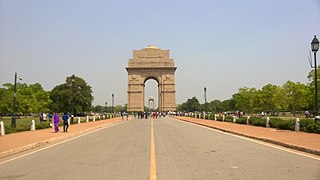
Rajpath, officially named Kartavya Path, and formerly known as Kingsway, is a ceremonial boulevard in New Delhi, India, that runs from Rashtrapati Bhavan on Raisina Hill through Vijay Chowk and India Gate, National War Memorial to National Stadium, Delhi. The avenue is lined on both sides by huge lawns, canals and rows of trees. Considered to be one of the most important roads in India, it is where the annual Republic Day parade takes place on 26 January. Janpath crosses the road. Rajpath runs in east-west direction. Roads from Connaught Place, the financial centre of Delhi, run into Rajpath from north. It was made during the Construction of New Delhi.

The Provisional Government of Free India or, more simply, Azad Hind, was a short-lived Japanese-supported provisional government in India. It was established in Japanese occupied Singapore during World War II in October 1943 and has been considered a puppet state of the Empire of Japan.

Indian nationalist leader Subhas Chandra Bose died on 18 August 1945 from third-degree burns sustained after the bomber in which he was being transported as a guest of Lieutenant General Tsunamasa Shidei of the Imperial Japanese Kwantung Army crashed upon take off from the airport in Taihoku, Japanese Formosa, now Taipei, Taiwan. The chief pilot, copilot, and General Shidei were instantly killed.
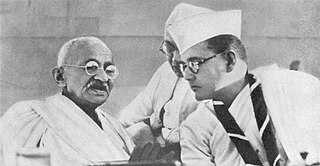
Subhas Chandra Bose also known as Netaji ,his political views were in support of complete freedom for India with a classless society and state socialism at the earliest, whereas most of the Congress Committee wanted it in phases, through a Dominion status.

Coronation Park is a park located at Burari Road near Nirankari Sarovar in Delhi, India. It was the venue of the Delhi Durbar of 1877 when Queen Victoria was proclaimed the Empress of India. Later it was used to celebrate the accession of King Edward VII in 1903, and, finally, it was here that the Durbar commemorating the coronation of King George V as Emperor of India took place on 12 December 1911, subsequent to his coronation at Westminster Abbey in June 1911. This last celebration had all the princely states in attendance. The decision to hold the Coronation Durbars in Delhi at the vast open ground at Coronation Park was a move to emphasise the historical significance of Delhi as the former capital of the Mughal Empire.

The Tokyo Cadets or the Tokyo Boys, was the name given to the group of forty five youth recruits of the Indian National Army who were sent to the Imperial Japanese Army Academy or Imperial Japanese Army Air Force Academy to train as fighter pilots in 1944 by Subhas Chandra Bose. The cadets were captured as prisoners of war after Japan surrendered, but were released in 1946 after the end of the INA trials. The cadets became officers in the Indian forces, Burma Navy, Pakistan forces, and private pilots. Some of them became general officers.

The Gates of Delhi were city gates at various medieval townships around Delhi, built under dynastic rulers in the period that could be dated from the 8th century to the 20th century. They are the gates in:

Netaji Bhawan or Netaji Bhavan is a heritage building in Kolkata, West Bengal, maintained as a memorial and research center to the life of the Indian nationalist "Netaji" Subhas Chandra Bose. It is currently the headquarters of Netaji Research Bureau.
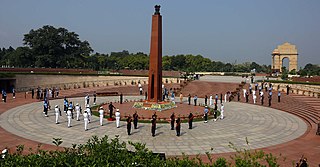
The National War Memorial is a war memorial in New Delhi, Delhi, India, located at India Gate Circle. It has been built to honour and remember soldiers of the Indian Armed Forces who fought in armed conflicts of independent India. The names of armed forces personnel killed during the armed conflicts with Pakistan and China as well as the 1961 War in Goa, Operation Pawan, and other operations such as Operation Rakshak are inscribed on the memorial walls in golden letters.
The Indian National Army (INA) and its leader Subhash Chandra Bose are popular and emotive topics within India. From the time it came into public perception in India around the time of the Red Fort Trials, it found its way into the works of military historians around the world. It has been the subject of a number of projects, of academic, historical and of popular nature. Some of these are critical of the army, some — especially of the ex-INA men — are biographical or autobiographical, while still others historical and political works, that tell the story of the INA. A large number of these provide analyses of Subhas Chandra Bose and his work with the INA.
The INA treasure controversy relates to alleged misappropriation by men of Azad Hind of the Azad Hind fortune recovered from belongings of Subhas Chandra Bose in his last known journey. The treasure, a considerable amount of gold ornaments and gems, is said to have been recovered from Bose's belongings following the fatal plane crash in Formosa that reportedly killed him, and taken to men of Azad Hind then living in Japan. The Indian government was made aware of a number of these individuals allegedly using part of the recovered treasure for personal use. However, despite repeated warnings from Indian diplomats in Tokyo, Nehru is said to have disregarded allegations that men previously associated with Azad Hind misappropriated the funds for personal benefit. Some of these are said to have travelled to Japan repeatedly with the approval of Nehru government and were later given government roles implementing Nehru's political and economic agenda. A very small portion of the alleged treasure was repatriated to India in the 1950s.

Amar Jawan Jyoti is an Indian memorial conceptualised and constructed after the Indo-Pakistani War of 1971 and inaugurated on 26 January 1972. It was the national war memorial in India until February 2019, when the new National War Memorial and its own flame was inaugurated and lit. On 21 January 2022, the older flame was merged with the newer one at National War Memorial.

The National Police Memorial in India commemorates the 34,844 police personnel from all of the central and state police forces in India who have died in the line of duty since the nation's Independence in 1947. Located in New Delhi's Chanakyapuri area, the 6.12 acres memorial consists of a 30-foot (9.1-metre) tall and 238-tonne heavy black granite central sculpture, a museum and a 'Wall of Valour' bearing the names of all 34,844 police personnel who have died in the line of duty. The underground museum is the first police museum of its kind in India, and showcases over 2000 years of policing in the region, since the time of Kautilya's system of law and order in 310 BCE.

Air Marshal Balabhadra Radha Krishna, is a retired officer of the Indian Air Force. He served as the Chief of Integrated Defence Staff from 30 September 2021 till 31 March 2023. He is former Air Officer Commanding-in-Chief (AOC-in-C), Western Air Command. He took over the office on 1 July 2021, following the elevation of Air Marshal Vivek Ram Chaudhari. Previously, he served as the Director General Air (Operations) and prior to that he served as Senior Air Staff Officer of South Western Air Command.
Adwaita Gadanayak is an Indian sculptor.

Statue of Subhas Chandra Bose, also known as the Netaji's Statue, is a monolithic statue made of black granite, dedicated to Netaji Subhas Chandra Bose, Indian freedom fighter and Commander-in-Chief of Indian National Army. The statue 28 feet (8.5 m) in total height, including a 8 feet (2.4 m) in total width. It is placed under the canopy behind India Gate in Delhi. The statue was sculpted by Mysuru-based sculptor Arun Yogiraj, whose other prominent works include the Statue of Adi Shankaracharya in Kedarnath. Prominent attendees at the dedication ceremony in 2022 included Prime Minister Narendra Modi, members of his cabinet, MP Hardeep Singh Puri, G. Kishan Reddy and Arjun Ram Meghwal.
The Statue of Mahatma Gandhi is a 16-foot (4.9 m) tall bronze statue of Mohandas Karamchand Gandhi located in the precincts of the Parliament House of India in New Delhi. Designed by Ram V. Sutar, it was inaugurated in 1993, and has become iconic as a site for protest by members of the Indian Parliament.
Arun Yogiraj is an Indian sculptor from Mysuru, Karnataka. He has carved the 30-feet statue of Subhash Chandra Bose, which was installed in the canopy behind the Amar Jawan Jyoti at the India Gate in New Delhi ahead of the 125th birth anniversary of Netaji Subhash Chandra Bose. His idol of Ram Lalla, the child form of Hindu god Rama, is also installed at Ayodhya's Ram Temple.














